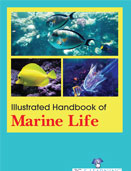Handbooks

Marine life refers to organisms that live in salt water. These can include a diverse array of plants, animals and microbes such as bacteria and archaea. At a fundamental level, marine life helps determine the very nature of our planet. Marine organisms produce much of the oxygen we breathe. Shorelines are in part shaped and protected by marine life, and some marine organisms even help create new land. This illustrated guide aims to introduce the broad diversity of marine life to amateur naturalists, beachcombers, divers and others who have an interest in life in the sea.
Marine life is the essence of Marine Biology, so in this Handbook we explore the science, biology, taxonomy, morphology, behavior, and ecological relationships of marine life that inhabits the ocean. Usually, marine biology is the study of life in the oceans and other saltwater environments such as estuaries and wetlands. All plant and animal life forms are included from the microscopic picoplankton all the way to the majestic blue whale, the largest creature in the sea?and for that matter in the world. The marine environment supplies many kinds of habitats that support marine life. Marine life depends in some way on the saltwater that is in the sea. A habitat is an ecological or environmental area inhabited by one or more living species. Most marine life is found in coastal habitats, even though the shelf area occupies only seven percent of the total ocean area. Open ocean habitats are found in the deep ocean beyond the edge of the continental shelf. Marine habitats can be modified by their inhabitants. Some marine organisms, like corals, kelp, mangroves and seagrasses, are ecosystem engineers which reshape the marine environment to the point where they create further habitat for other organisms. The health and well-being of coastal populations are intimately linked to the quality of the coastal marine environment.
Illustrated Handbook of Marine Life is intended to provide a comprehensive coverage of the common animals and covers a different group of marine life. Many of the species can be found in shallow waters, on shores and reefs on the seashore. All major kinds of living marine organisms are described, from seaweeds to seabirds, seawhips to seahorses, both common and obscure. The majority of our world is covered by oceans and all life on Earth originally came from the oceans, but our knowledge of what goes on in it is still very limited compared to what we know about land life. Many careers in marine biology are about studying the life histories and ecology of commercially important fish and shellfish to better understand how to regulate the fisheries and ensure that we will continue to have our favorite seafood for generations to come. On a conservation level, to better understand how to create and manage marine sanctuaries - for commercially important marine life, for marine life we happen to really like such as sea turtles, and the ecosystems that support them. To do that, we must study how the ecosystems function and how individual areas are linked to other areas containing the same species. And finally, to understand how global climate change affects marine life. Studying marine life is in a position to understand what patterns are normal and what would be a significant change away from normal.
Illustrated Handbook of Marine Life is aimed at the evolution and classification of marine mammals and their general biology and discusses the issues facing marine mammals, as well as discussions on how they can be addressed and how society can enjoy observing the animals while making sure they are preserved.